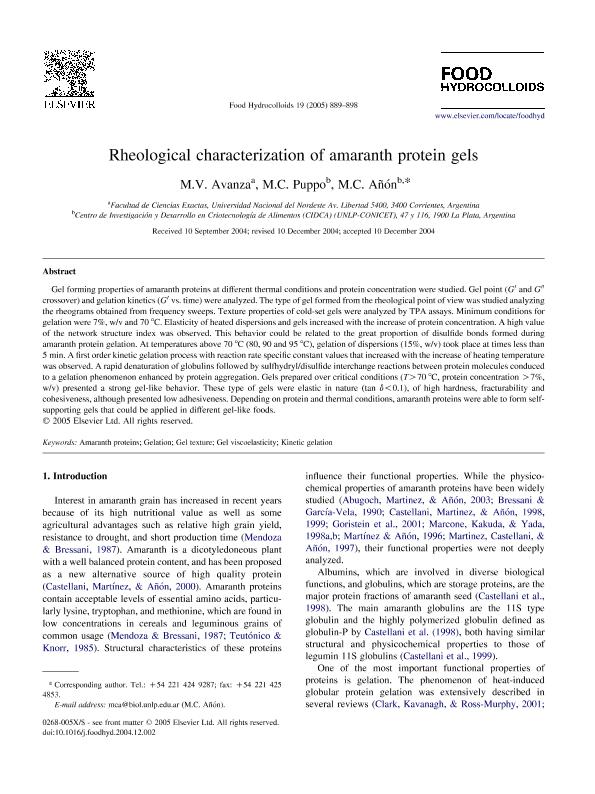Mostrar el registro sencillo del ítem
dc.contributor.author
Avanza, María Victoria

dc.contributor.author
Puppo, Maria Cecilia

dc.contributor.author
Añon, Maria Cristina

dc.date.available
2022-02-07T14:13:30Z
dc.date.issued
2005-09
dc.identifier.citation
Avanza, María Victoria; Puppo, Maria Cecilia; Añon, Maria Cristina; Rheological characterization of amaranth protein gels; Elsevier; Food Hydrocolloids; 19; 5; 9-2005; 889-898
dc.identifier.issn
0268-005X
dc.identifier.uri
http://hdl.handle.net/11336/151446
dc.description.abstract
Gel forming properties of amaranth proteins at different thermal conditions and protein concentration were studied. Gel point (G′ and G″ crossover) and gelation kinetics (G′ vs. time) were analyzed. The type of gel formed from the rheological point of view was studied analyzing the rheograms obtained from frequency sweeps. Texture properties of cold-set gels were analyzed by TPA assays. Minimum conditions for gelation were 7%, w/v and 70°C. Elasticity of heated dispersions and gels increased with the increase of protein concentration. A high value of the network structure index was observed. This behavior could be related to the great proportion of disulfide bonds formed during amaranth protein gelation. At temperatures above 70°C (80, 90 and 95°C), gelation of dispersions (15%, w/v) took place at times less than 5 min. A first order kinetic gelation process with reaction rate specific constant values that increased with the increase of heating temperature was observed. A rapid denaturation of globulins followed by sulfhydryl/disulfide interchange reactions between protein molecules conduced to a gelation phenomenon enhanced by protein aggregation. Gels prepared over critical conditions (T>70°C, protein concentration >7%, w/v) presented a strong gel-like behavior. These type of gels were elastic in nature (tan δ<0.1), of high hardness, fracturability and cohesiveness, although presented low adhesiveness. Depending on protein and thermal conditions, amaranth proteins were able to form self-supporting gels that could be applied in different gel-like foods.
dc.format
application/pdf
dc.language.iso
eng
dc.publisher
Elsevier

dc.rights
info:eu-repo/semantics/openAccess
dc.rights.uri
https://creativecommons.org/licenses/by-nc-sa/2.5/ar/
dc.subject
AMARANTH PROTEINS
dc.subject
GEL TEXTURE
dc.subject
GEL VISCOELASTICITY
dc.subject
GELATION
dc.subject
KINETIC GELATION
dc.subject.classification
Alimentos y Bebidas

dc.subject.classification
Otras Ingenierías y Tecnologías

dc.subject.classification
INGENIERÍAS Y TECNOLOGÍAS

dc.title
Rheological characterization of amaranth protein gels
dc.type
info:eu-repo/semantics/article
dc.type
info:ar-repo/semantics/artículo
dc.type
info:eu-repo/semantics/publishedVersion
dc.date.updated
2021-12-03T19:56:36Z
dc.journal.volume
19
dc.journal.number
5
dc.journal.pagination
889-898
dc.journal.pais
Países Bajos

dc.journal.ciudad
Amsterdam
dc.description.fil
Fil: Avanza, María Victoria. Universidad Nacional del Nordeste; Argentina. Consejo Nacional de Investigaciones Científicas y Técnicas; Argentina
dc.description.fil
Fil: Puppo, Maria Cecilia. Provincia de Buenos Aires. Gobernación. Comisión de Investigaciones Científicas. Centro de Investigación y Desarrollo en Criotecnología de Alimentos. Consejo Nacional de Investigaciones Científicas y Técnicas. Centro Científico Tecnológico Conicet - La Plata. Centro de Investigación y Desarrollo en Criotecnología de Alimentos. Universidad Nacional de La Plata. Facultad de Ciencias Exactas. Centro de Investigación y Desarrollo en Criotecnología de Alimentos; Argentina
dc.description.fil
Fil: Añon, Maria Cristina. Provincia de Buenos Aires. Gobernación. Comisión de Investigaciones Científicas. Centro de Investigación y Desarrollo en Criotecnología de Alimentos. Consejo Nacional de Investigaciones Científicas y Técnicas. Centro Científico Tecnológico Conicet - La Plata. Centro de Investigación y Desarrollo en Criotecnología de Alimentos. Universidad Nacional de La Plata. Facultad de Ciencias Exactas. Centro de Investigación y Desarrollo en Criotecnología de Alimentos; Argentina
dc.journal.title
Food Hydrocolloids

dc.relation.alternativeid
info:eu-repo/semantics/altIdentifier/url/https://www.sciencedirect.com/science/article/pii/S0268005X05000032
dc.relation.alternativeid
info:eu-repo/semantics/altIdentifier/doi/http://dx.doi.org/10.1016/j.foodhyd.2004.12.002
Archivos asociados
